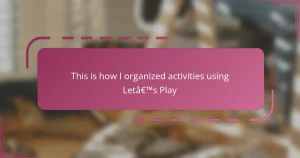Key takeaways
- Storytime at libraries fosters language development, boosts creativity, and enhances social skills in children.
- It provides a supportive community for parents, offering a space to connect and share experiences.
- Choosing the right storytime session involves considering the child’s age, the storyteller’s style, and the overall atmosphere.
- Engaging actively during sessions and following up with related activities at home deepens the storytime experience.
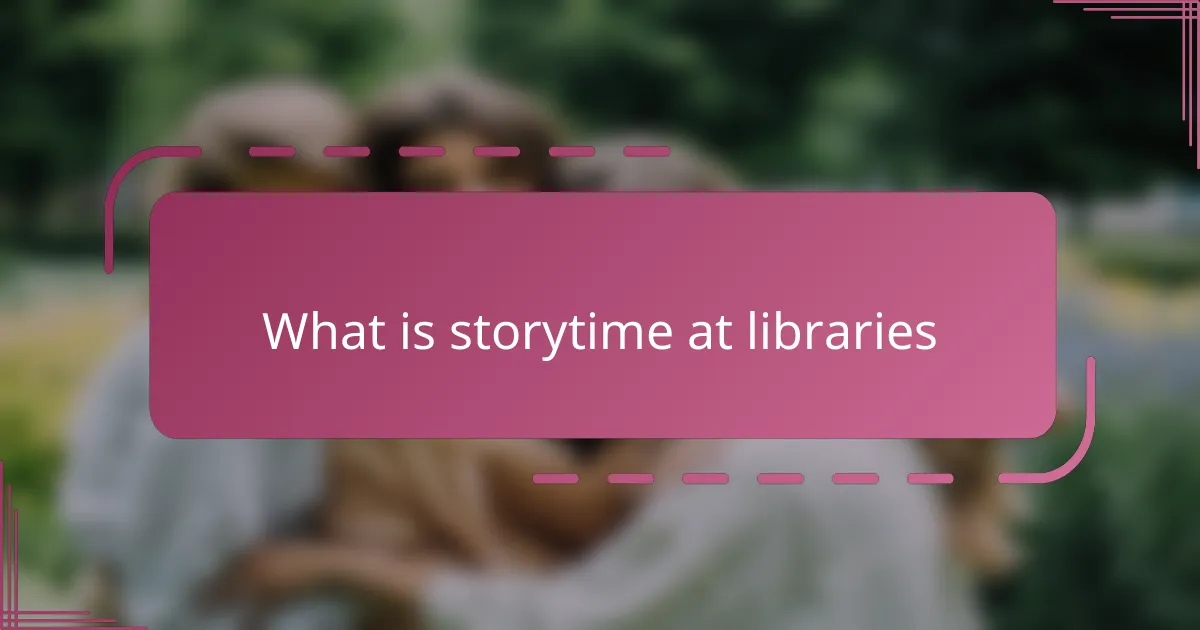
What is storytime at libraries
Storytime at libraries is a special gathering where kids and caregivers come together to listen to stories read aloud. I remember attending these sessions with my little one and feeling how the rhythmic storytelling instantly captured their imagination and curiosity. Have you ever noticed how a simple story shared aloud can turn a quiet room into a place full of wonder?
These sessions often include songs, fingerplays, or simple activities that make stories come alive. From my experience, the interactive nature of storytime helps children connect with the books and each other in a way that’s both fun and meaningful. It’s not just reading; it’s creating a shared moment that encourages a lifelong love of stories.
What really strikes me is how storytime at libraries provides a safe and welcoming space for families to build community. As a parent, knowing that my child is engaged in a group of peers who are also discovering the magic of books feels incredibly reassuring. Isn’t that what every parent hopes for?
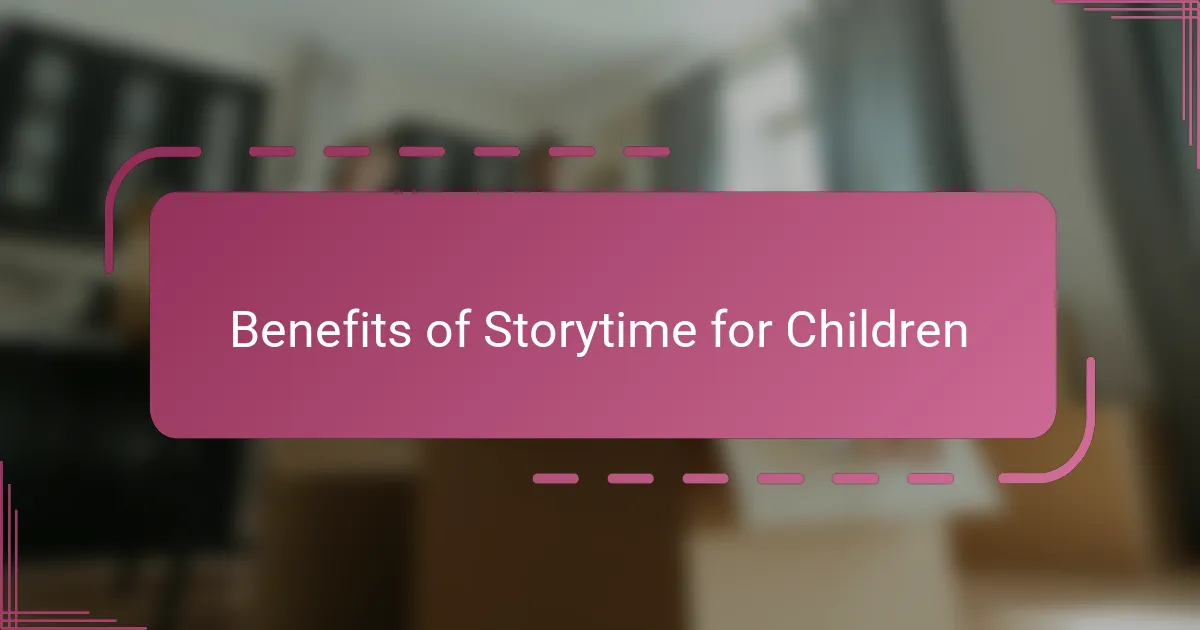
Benefits of storytime for children
One of the biggest benefits I’ve noticed with storytime is how it boosts children’s language skills without them even realizing it. Hearing stories aloud introduces new words and phrases in a natural way, which I found way more effective than just drilling vocabulary at home. Have you ever caught your child repeating a funny phrase or new word from a storytime session? That moment always felt like a little victory to me.
Another thing that stood out to me is how storytime sparks creativity and imagination. Watching my child’s eyes light up during a tale or seeing them act out characters afterward made me realize that these sessions do more than just entertain — they plant seeds for creative thinking. It’s amazing how a simple story can unlock a whole world inside a child’s mind.
Lastly, storytime provides more than just educational perks—it nurtures social skills too. I’ve seen shy kids gradually gain confidence by participating, and families bonding over shared experiences. Isn’t it comforting to know your child is not only learning but also feeling connected in a supportive group setting? For me, that sense of belonging has been just as important as the stories themselves.
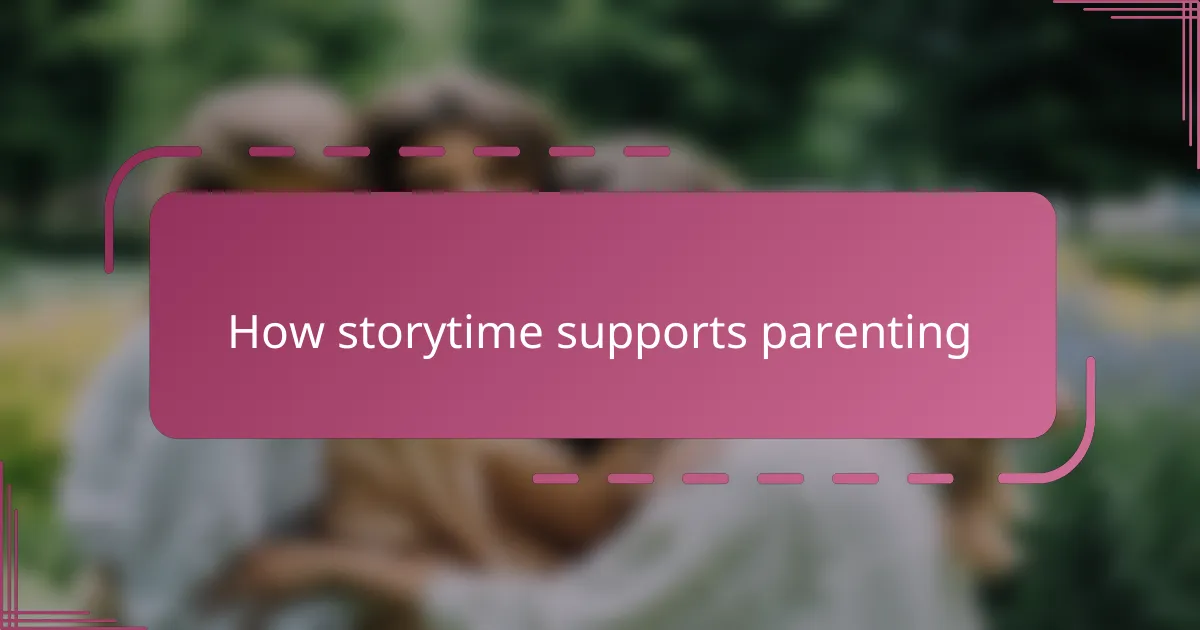
How storytime supports parenting
When I first took my child to storytime, I quickly realized it wasn’t just about the stories—it was a subtle coaching session in parenting. Seeing how the librarian’s gentle guidance encouraged participation gave me ideas on how to engage my little one more effectively at home. Have you ever felt unsure about ways to support your child’s love of reading? Storytime quietly shows you how.
What truly impressed me is how these sessions offer a break from the usual parenting pressures. While the kids are happily engrossed, I found a moment to relax and connect with other parents who understand the joys and challenges of raising young children. That shared understanding turned storytime into a small parenting community, something I hadn’t expected but deeply appreciated.
Sometimes, I wonder how many parents realize that storytime also models patience and attentive listening for children—and for us. Watching my child wait their turn or respond thoughtfully made me reflect on how important these social skills are. Isn’t it comforting to see these lessons woven so naturally into a fun experience? For me, those subtle parenting wins have been priceless.
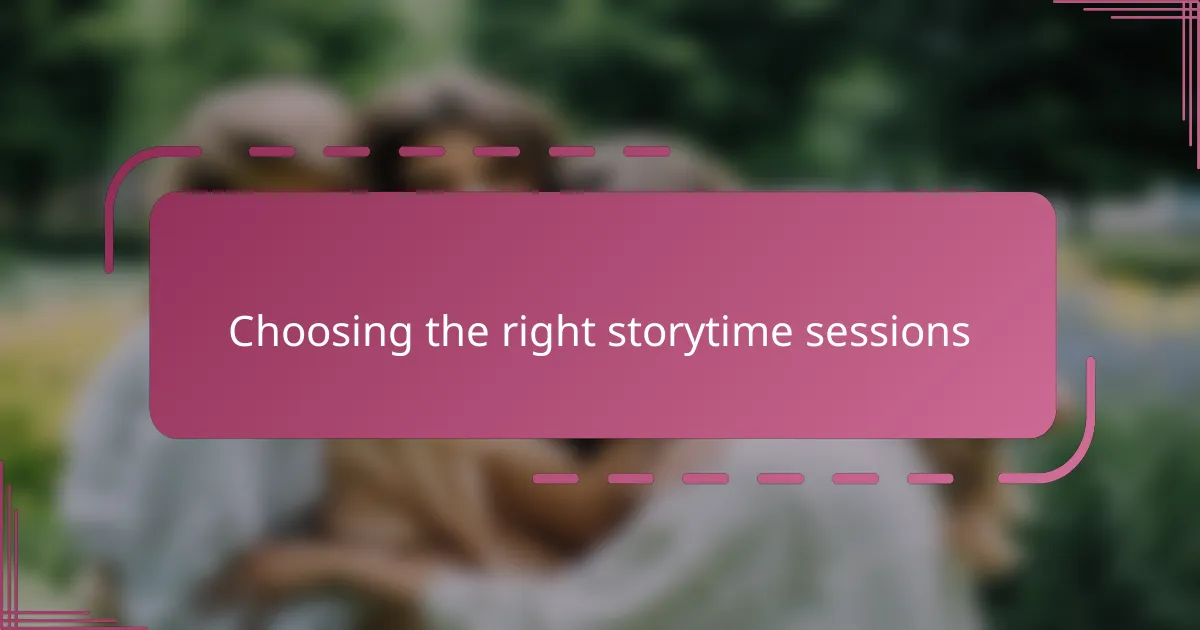
Choosing the right storytime sessions
Choosing the right storytime session felt overwhelming at first—I wondered if all storytimes were created equal. From my experience, it really helps to look for sessions that match your child’s age and interests, so the stories and activities truly resonate. Have you noticed how a perfectly timed story captures your child’s attention much more deeply?
I also learned to consider the style of the storyteller. Some librarians bring stories to life with energy and expression, while others keep it calm and soothing. Finding a storyteller who sparks your child’s excitement made a huge difference for us, turning storytime into something my little one eagerly anticipated each week.
Lastly, I think about the session’s vibe—whether it’s more structured or relaxed. Sometimes, I needed a lively setting that encouraged participation, and other times, a gentle approach suited us better. How do you know what’s best? Honestly, trying different sessions until you find one that feels like a good fit brought us joy and kept the love of stories growing.
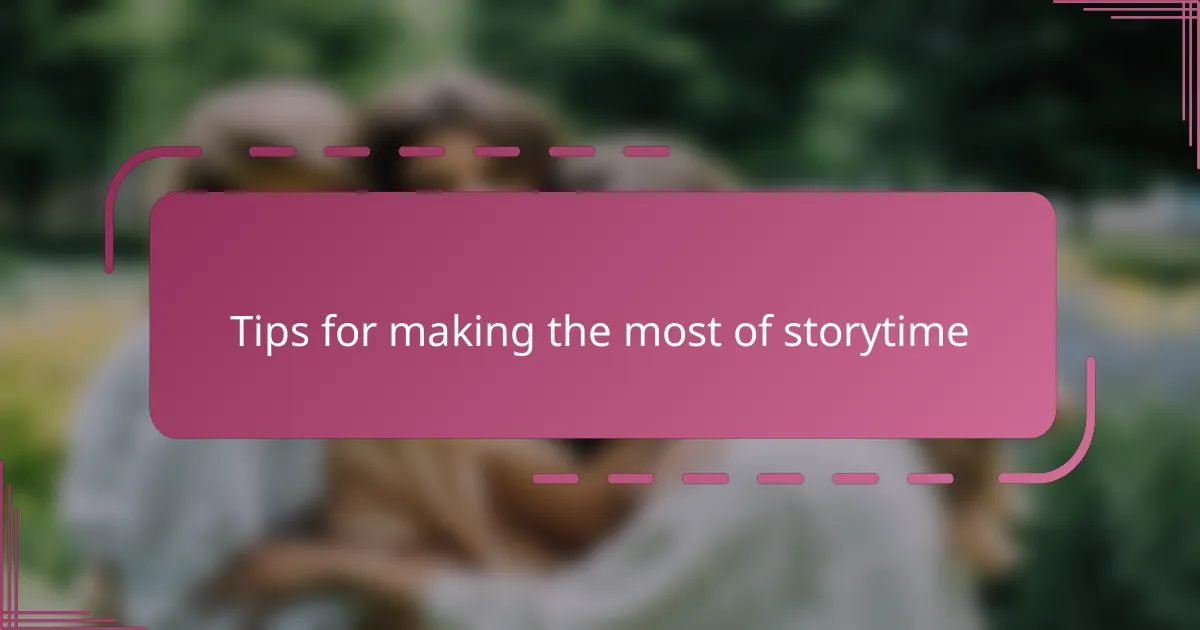
Tips for making the most of storytime
One tip I always recommend is arriving a little early to settle in and let your child acclimate to the space. I’ve noticed that when my child feels comfortable beforehand, they’re more eager to join in and less distracted by the new environment. Have you ever seen how a few quiet minutes can turn jitters into excitement?
Engaging actively during storytime makes a huge difference too. I try to participate alongside my child—singing, answering questions, or making silly faces when encouraged. It not only models enthusiasm but creates memories we both cherish. What’s a favorite storytime moment you and your little one share?
Lastly, don’t hesitate to follow up after the session with related activities at home. Whether it’s drawing a character or acting out the story, these extensions deepen the experience and keep the magic alive. I found that bringing storytime into our daily routine turned a simple library visit into ongoing adventure. How do you keep the storytime spark glowing beyond the library walls?
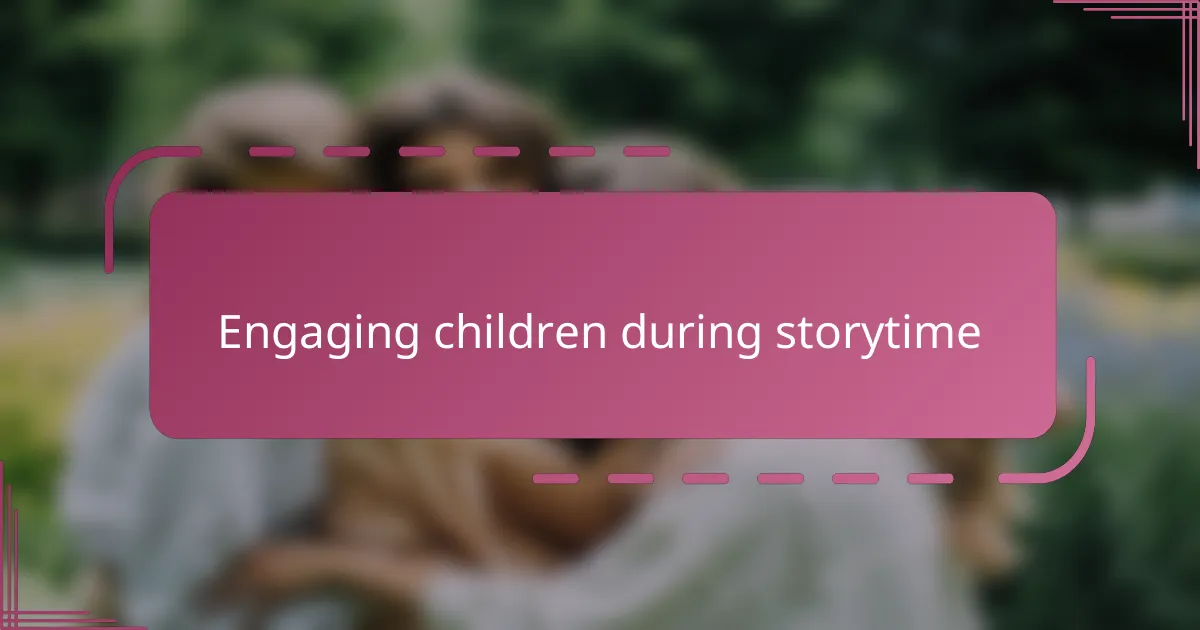
Engaging children during storytime
Capturing a child’s attention during storytime can sometimes feel like trying to catch butterflies—elusive but utterly magical when it happens. I’ve found that using lively voices and expressive gestures makes a world of difference. When I switch up my tone or mimic a character’s quirks, my child’s eyes widen, and suddenly, the story isn’t just words; it’s an adventure unfolding right before us.
I’ve also noticed that involving kids through questions or simple actions keeps their little minds engaged. Asking “What do you think happens next?” or encouraging a chorus of animal sounds turns passive listening into active participation. It’s amazing how just a few interactive moments create a sense of ownership over the story, making children eager to come back for more.
Sometimes, the real secret is simply tuning into each child’s mood and energy. On days when my little one is restless, I’ve learned to pick shorter stories or incorporate quick songs to regain focus. Have you ever adapted a storytime on the fly? Those moments of flexibility, in my view, transform storytelling into a shared dance of connection rather than a one-sided recital.
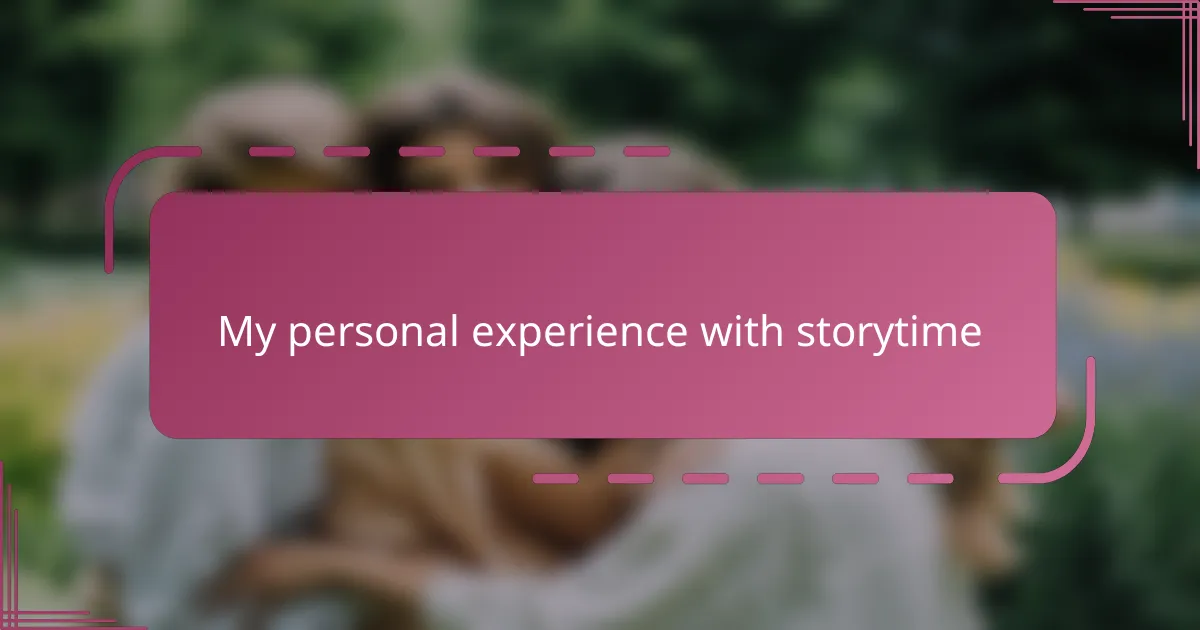
My personal experience with storytime
When I first brought my child to storytime, I was amazed at how quickly they settled into the routine, eyes bright with curiosity. It felt like witnessing a little world opening up before us, where words and pictures sparked genuine joy. Have you ever caught your child completely absorbed, as if nothing else exists in that moment? For me, those scenes are priceless reminders of why storytime matters.
One particular day stands out when my child, usually shy, suddenly joined in a group song without hesitation. That breakthrough made me realize how storytime isn’t just about stories—it’s about confidence building in a warm, welcoming space. I often think about how many parents see these subtle changes in their kids, and it gives me hope that these small moments really do add up.
I also remember the comforting rhythm of arriving each week, feeling part of a community that values stories and connection. The shared smiles and knowing nods from other parents made those chilly mornings feel less lonely and more like a collective adventure. Isn’t it amazing how something as simple as storytime can create bonds that go beyond the pages of a book?
